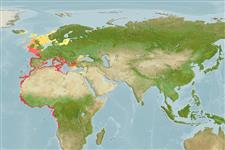Classification / Names
Common names from other countries
Main reference
Size / Weight / Age
Max length : 70.0 cm TL male/unsexed; (Ref. 57392); common length : 35.0 cm NG male/unsexed; (Ref. 26999); max. published weight: 2.8 kg (Ref. 27584)
Environment
Marine; brackish; pelagic-neritic; depth range 50 - 200 m (Ref. 27000)
Climate / Range
Subtropical, preferred 21°C (Ref. 107945); 66°N - 13°S, 19°W - 36°E
Distribution
Eastern Atlantic: Bay of Biscay, British and Scandinavian waters (rare vagrant) to Angola, including the Mediterranean Sea and offshore islands.
Countries | FAO areas | Ecosystems | Occurrences | Introductions
Short description
Dorsal
spines
(total): 7;
Dorsal
soft rays
(total): 23-27;
Anal
spines: 3;
Anal
soft rays: 22 - 25. Diagnosis: body moderately long (its depth 2.6-3.5 times in fork length) and compressed; upper jaw very narrow at posterior end and extending only to below anterior third of eye; 22-32 gill rakers on lower limb of first gill arch; 2 dorsal fins, 1st with 6 spines, 2nd with 1 spine and 23-27 soft rays; anal fin with 2 detached spines followed by 1 spine and 22-25 soft rays; lobes of soft dorsal and anal fins small (Ref. 57392). Length of second dorsal fin base equal to length of anal fin base (Ref. 35388). 2nd dorsal-fin lobe and pectoral fins shorter than head; scales small, cycloid, partially embedded in skin; lateral line very slightly arched over pectoral fins, straight thereafter, and without scutes (Ref. 57392). 3-5 black spots along anterior half of lateral line(Ref. 35388, 57392).
Coloration: back greenish-grey, sides silvery with 3-5 vertically elongate black spots on anterior half of lateral line; dorsal-, anal- and caudal-fin lobes black-tipped (Ref. 57392).
IUCN Red List Status (Ref. 115185)
Threat to humans
Harmless
Human uses
Fisheries: minor commercial; aquaculture: commercial; gamefish: yes
More information
ReferencesAquacultureAquaculture profileStrainsGeneticsAllele frequenciesHeritabilityDiseasesProcessingMass conversion
Tools
Special reports
Download XML
Internet sources
Estimates of some properties based on models
Phylogenetic diversity index
PD50 = 0.5000 many relatives (e.g. carps) 0.5 - 2.0 few relatives (e.g. lungfishes)
Trophic Level
3.7 ±0.58 se; Based on food items.
Resilience
Medium, minimum population doubling time 1.4 - 4.4 years (Preliminary K or Fecundity.)
Vulnerability
Moderate vulnerability (40 of 100)
Price category
